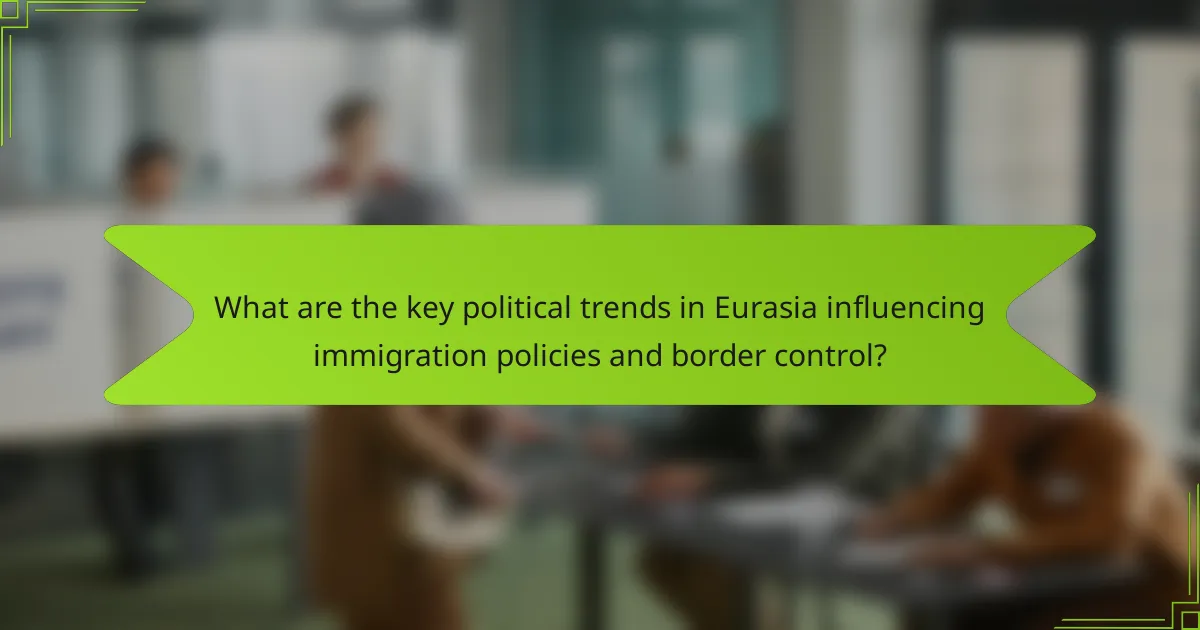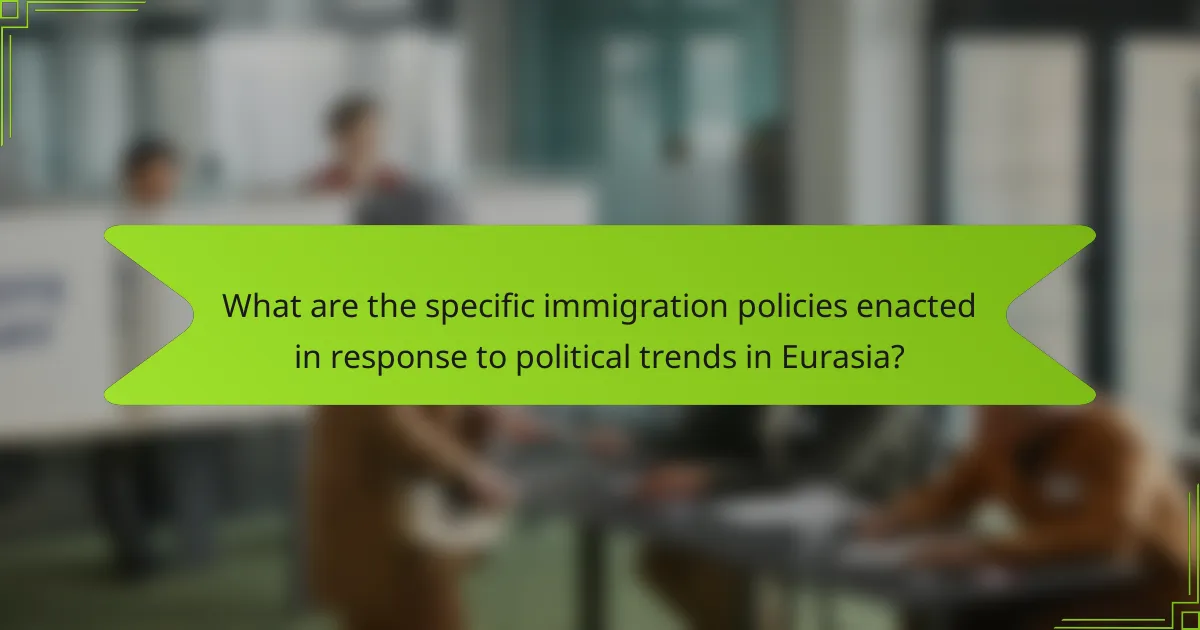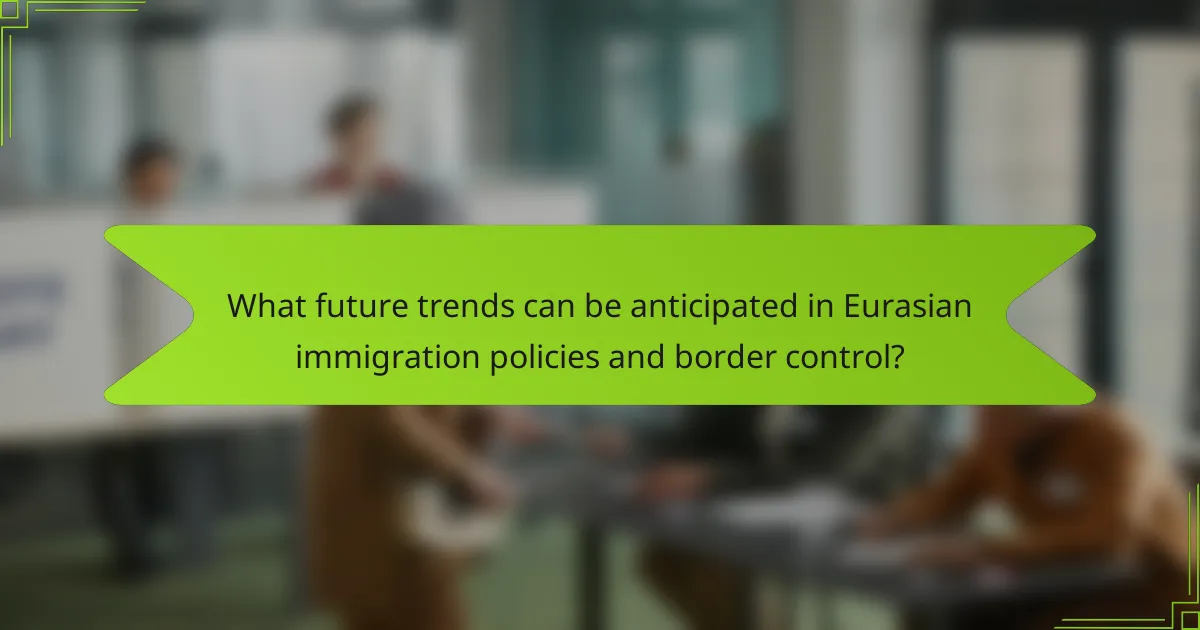Eurasian political trends significantly influence immigration policies and border control across the region. Rising nationalism, geopolitical tensions, and economic migration are key factors shaping these policies. Countries such as Hungary and Poland are enacting stricter immigration laws driven by nationalist movements, while Russia is tightening border controls due to geopolitical conflicts. Economic migration from Central Asia to Russia highlights labor shortages, prompting various nations to adopt diverse immigration strategies. Future trends are expected to emphasize regional cooperation, enhanced border security, and the use of technology to streamline immigration processes, reflecting the complex interplay of political, economic, and social dynamics in Eurasia.

What are the key political trends in Eurasia influencing immigration policies and border control?
Key political trends in Eurasia influencing immigration policies and border control include rising nationalism, geopolitical tensions, and economic migration. Nationalist movements in countries like Hungary and Poland promote stricter immigration laws. Geopolitical tensions, especially between Russia and Western nations, lead to increased border security. Economic migration from Central Asia to Russia is driven by labor shortages. Additionally, the influence of international organizations affects policy formulation. For example, the Eurasian Economic Union facilitates labor movement among member states. These trends reflect broader global patterns impacting immigration and border control strategies in the region.
How do historical events shape contemporary immigration policies in Eurasia?
Historical events significantly influence contemporary immigration policies in Eurasia. The dissolution of the Soviet Union in 1991 led to increased migration across former Soviet states. This event created new borders and national identities, impacting immigration laws. Conflicts in the region, such as the wars in Chechnya and the Balkans, have also shaped policies to manage refugee flows. Economic factors, including the 2008 financial crisis, prompted countries to tighten immigration regulations. Additionally, historical colonial ties influence migration patterns and policies in various Eurasian countries. For instance, countries like Russia have specific immigration pathways for individuals from former Soviet republics. These historical contexts create a complex landscape for immigration policies today.
What historical events have had the most significant impact on current policies?
The fall of the Soviet Union in 1991 significantly impacted current immigration policies in Eurasia. This event led to the emergence of independent states and the redefinition of borders. The resulting geopolitical changes caused shifts in migration patterns. Many former Soviet citizens sought opportunities in Western Europe and North America. The 9/11 attacks in 2001 also reshaped global immigration policies. Nations tightened border controls in response to security concerns. The European migrant crisis in 2015 further influenced immigration policies across Europe. This crisis led to debates on asylum and border security. Each of these events has left a lasting mark on contemporary immigration frameworks.
How do these historical influences vary across different Eurasian countries?
Historical influences on immigration policies and border control vary significantly across Eurasian countries. In Russia, the legacy of the Soviet Union shapes strict border control and a focus on national security. Historical conflicts in Central Asia lead to cautious immigration policies aimed at preserving ethnic majorities. In contrast, Western European countries in Eurasia, like Germany, have adopted more open policies influenced by historical migration patterns and economic needs. The Ottoman Empire’s history impacts Turkey’s immigration stance, balancing between Europe and Asia. China’s historical emphasis on internal stability results in tight immigration regulations. Each country’s unique historical context directly influences its contemporary immigration policies and border control strategies.
What role do economic factors play in shaping immigration policies in Eurasia?
Economic factors significantly influence immigration policies in Eurasia. Countries in this region often adjust their immigration policies based on labor market needs. For instance, nations with labor shortages may ease visa restrictions to attract foreign workers. Conversely, during economic downturns, stricter immigration controls may be implemented to protect local jobs.
The demand for skilled labor drives many Eurasian countries to create programs for highly qualified immigrants. Economic growth can lead to more favorable conditions for immigrants, such as better integration policies. Conversely, high unemployment rates often result in public sentiment against immigration.
Data from the International Organization for Migration indicates that economic stability correlates with more open immigration policies. Countries like Russia and Kazakhstan have adjusted their immigration laws to align with economic objectives. This demonstrates that economic factors are a key driver in shaping immigration policies across Eurasia.
How do economic conditions affect immigration trends in the region?
Economic conditions significantly influence immigration trends in the region. Strong economies attract immigrants seeking better job opportunities. For example, during economic booms, countries often experience increased immigration rates. In contrast, economic downturns lead to stricter immigration policies and reduced inflow. Data from the International Organization for Migration shows that a 1% increase in GDP correlates with a 0.5% rise in immigration. Additionally, regions with high unemployment rates typically see a decline in immigration. These trends highlight the direct relationship between economic stability and immigration patterns.
What specific economic indicators are most influential on immigration policies?
The specific economic indicators most influential on immigration policies include unemployment rates, GDP growth, and wage levels. Unemployment rates directly affect labor demand. Higher unemployment often leads to stricter immigration controls. GDP growth indicates economic health and can attract immigrants for job opportunities. Wage levels influence the attractiveness of a country for immigrants seeking better income. For instance, countries with rising wages may see increased immigration as individuals seek higher living standards. Additionally, economic stability can impact public sentiment towards immigration policies.
How do social and cultural dynamics impact border control measures in Eurasia?
Social and cultural dynamics significantly influence border control measures in Eurasia. These dynamics shape national identities and perceptions of security. For instance, cultural ties between neighboring countries can lead to more lenient border policies. Conversely, historical conflicts may result in stricter controls. Ethnic diversity within nations often complicates border management, prompting governments to address various cultural groups’ needs. Additionally, migration patterns driven by cultural affinities can impact policy decisions. Countries with shared cultural heritage may prioritize cooperation over enforcement. This interplay of social factors ultimately determines the effectiveness and approach of border control measures in the region.
What social factors contribute to the shaping of immigration policies?
Social factors significantly shape immigration policies. Public opinion influences lawmakers’ decisions on immigration. Economic conditions affect perceptions of immigrants’ contributions. Cultural attitudes towards diversity impact policy acceptance. Social movements advocate for immigrant rights, altering legislative landscapes. Demographic changes can shift political priorities regarding immigration. Historical context informs current policy frameworks. These factors interplay to create dynamic immigration policies that reflect societal values and needs.
How do cultural attitudes towards immigrants vary across Eurasian nations?
Cultural attitudes towards immigrants vary significantly across Eurasian nations. In Western Europe, countries like Germany and France generally exhibit more welcoming attitudes towards immigrants. This is influenced by historical ties and economic needs. In contrast, Eastern European nations such as Hungary and Poland often display more restrictive attitudes. These nations prioritize national identity and security concerns.
In Central Asia, countries like Kazakhstan show a mixed approach. They have a history of migration and often embrace immigrants, yet there are underlying tensions related to ethnic identity. Russia presents a complex picture as well, with a significant immigrant population from former Soviet states, but also rising nationalism that can lead to discrimination.
Public opinion surveys reveal these differences. For instance, a 2021 Pew Research study indicated that acceptance levels vary, with Western Europeans generally more favorable towards immigrants compared to their Eastern counterparts. Historical contexts and socio-economic factors play crucial roles in shaping these attitudes across the region.

What are the specific immigration policies enacted in response to political trends in Eurasia?
Eurasian countries have enacted various immigration policies in response to political trends. Russia has implemented stricter border controls, particularly for migrants from Central Asia. This includes a requirement for work permits and increased documentation verification. In response to regional conflicts, countries like Ukraine have adjusted their asylum policies to accommodate refugees. Belarus has adopted policies to attract foreign workers, offering streamlined visa processes. Additionally, Kazakhstan has introduced a points-based immigration system to attract skilled labor. These policies reflect the shifting political landscape and economic needs within the region.
How do different countries in Eurasia approach immigration control?
Different countries in Eurasia approach immigration control with varying policies and practices. For instance, Russia employs strict entry regulations, requiring visas for most foreign nationals. It also has a system of quotas for migrant workers, reflecting its labor market needs. In contrast, countries like Kazakhstan have more flexible immigration policies to attract skilled labor and investment. They offer various residency permits to facilitate this. Eastern European nations, such as Poland, have tightened their borders in response to regional security concerns and an influx of refugees. These countries often emphasize border security and surveillance. Overall, immigration control in Eurasia is influenced by economic needs, security concerns, and political trends.
What are the key differences in immigration policies among Eurasian countries?
Eurasian countries exhibit significant differences in their immigration policies. For example, Russia has a relatively open policy for migrants from former Soviet states, allowing easier access and residency. In contrast, countries like Kazakhstan implement stricter regulations, requiring work permits and residency documentation for foreign workers.
Additionally, countries such as Belarus maintain a more centralized immigration approach, focusing on economic migrants with specific skills. Conversely, countries like Turkey enforce stringent border controls and prioritize security concerns, impacting the flow of refugees and asylum seekers.
These variations reflect each nation’s political climate, economic needs, and historical context regarding migration. For instance, the European Union’s influence on Turkey’s policies highlights the geopolitical factors shaping immigration strategies in the region.
How do these policies reflect the political climate in each country?
Immigration policies reflect the political climate in each country by aligning with national interests and public sentiment. In authoritarian regimes, policies often prioritize state security and control over immigration. For example, Russia has implemented strict border controls to curb immigration, reflecting its focus on national sovereignty. In contrast, democratic nations may adopt more open immigration policies to promote diversity and economic growth. For instance, Germany’s immigration policies have evolved to address labor shortages, showcasing its commitment to economic stability. These policies serve as indicators of broader political ideologies and governmental priorities.
What are the implications of these immigration policies on border control?
Immigration policies significantly impact border control by shaping enforcement strategies and resource allocation. Stricter immigration policies often lead to enhanced border security measures. This includes increased surveillance and personnel at border crossings. Countries may invest in technology to monitor border activities more effectively. Additionally, immigration policies can influence international cooperation on border management. For example, countries may engage in joint operations to combat illegal crossings. Historical data shows that changes in immigration laws correlate with shifts in border control tactics. In the U.S., the introduction of the Secure Fence Act in 2006 led to a substantial increase in border patrol agents and infrastructure. Thus, immigration policies directly dictate how borders are managed and controlled.
How do immigration policies influence the effectiveness of border control measures?
Immigration policies significantly influence the effectiveness of border control measures. Strict immigration policies can enhance border control by establishing clear guidelines for entry and exit. These policies often lead to increased resources for enforcement agencies. Enhanced training and technology can improve detection and prevention of illegal crossings. Conversely, lenient immigration policies may undermine border control effectiveness. They can create loopholes that facilitate unauthorized entry. Historical data shows that countries with stringent immigration laws often report lower illegal immigration rates. For instance, the U.S. saw a decrease in unauthorized entries after implementing stricter border policies in the 1990s. Thus, the alignment of immigration policies with border control strategies is crucial for achieving desired outcomes.
What challenges do countries face in implementing these policies at their borders?
Countries face significant challenges in implementing border policies due to varying political climates. Disagreements among nations on immigration standards complicate cooperation. Resource limitations hinder effective border control measures. Additionally, geopolitical tensions can lead to enforcement inconsistencies. Public opinion often influences policy implementation, creating domestic pressure. Corruption within border agencies can undermine policy effectiveness. Lastly, technological gaps in border management systems affect efficiency and security.

What future trends can be anticipated in Eurasian immigration policies and border control?
Future trends in Eurasian immigration policies and border control will likely focus on increased regional cooperation and stricter regulations. Countries may enhance bilateral agreements to manage migration flows effectively. The rise of security concerns could lead to more robust border security measures. Technological advancements will likely play a significant role in monitoring and controlling borders. Data-sharing initiatives among nations may improve the efficiency of immigration processes. Additionally, economic factors will influence policies, as countries seek skilled labor to support growth. Demographic shifts may prompt nations to reassess their immigration strategies. These trends reflect the complex interplay of political, economic, and social factors shaping Eurasian immigration policies.
How might geopolitical shifts affect future immigration policies in Eurasia?
Geopolitical shifts will likely lead to significant changes in future immigration policies in Eurasia. These shifts can arise from changes in political power, economic conditions, and security concerns. For example, countries may tighten immigration policies in response to perceived threats from neighboring states. Historical trends show that during periods of conflict, such as the Ukraine crisis, nations often adopt more restrictive immigration measures. Conversely, economic partnerships may encourage more open immigration policies to facilitate labor mobility. The rise of nationalism in several Eurasian countries has also led to a preference for stricter immigration controls. As geopolitical alliances evolve, countries may adjust their immigration policies to align with new partners or to counteract rival states. Therefore, the interplay of these factors will shape the future landscape of immigration in the region.
What potential geopolitical changes are on the horizon for Eurasia?
Potential geopolitical changes on the horizon for Eurasia include shifting alliances and increased regional conflicts. Tensions between Russia and NATO continue to rise, influencing security dynamics. China’s Belt and Road Initiative is expanding its influence across the region. This initiative promotes infrastructure development but raises concerns about debt dependency. Additionally, the withdrawal of U.S. forces from Afghanistan has created a power vacuum. Regional players are likely to vie for influence in Central Asia. Climate change is also impacting migration patterns, creating new challenges for border control. These factors collectively shape the geopolitical landscape of Eurasia.
How could these changes reshape immigration and border control strategies?
Changes in Eurasian political trends could significantly reshape immigration and border control strategies. These shifts may lead to stricter border enforcement and revised immigration policies. For instance, an increase in nationalist sentiments often results in reduced immigration quotas. Countries may prioritize security over openness, affecting asylum processes and refugee admissions. Additionally, collaborative efforts among neighboring nations could enhance border control mechanisms. Enhanced technology and surveillance may be adopted to monitor borders more effectively. Historical examples include the European migration crisis, which prompted countries to tighten border controls. Such adaptations can create a ripple effect across regions, influencing global immigration dynamics.
What best practices can be adopted for effective immigration policy development in Eurasia?
Effective immigration policy development in Eurasia can be achieved through several best practices. First, comprehensive stakeholder engagement is essential. Involving government agencies, civil society, and affected communities ensures diverse perspectives are considered. Second, data-driven decision-making enhances policy effectiveness. Utilizing accurate demographic and economic data allows for informed policy adjustments. Third, establishing clear legal frameworks promotes consistency and transparency in immigration processes. Fourth, fostering regional cooperation among Eurasian countries can streamline border control and share best practices. Finally, ongoing policy evaluation and adaptation are crucial. Regular assessments help identify areas for improvement and respond to changing dynamics. These practices are supported by successful immigration models in various Eurasian nations, demonstrating their effectiveness in addressing complex immigration challenges.
How can countries learn from each other’s immigration policies?
Countries can learn from each other’s immigration policies by analyzing successful frameworks and outcomes. By studying policy impacts, nations can identify best practices. Comparative studies reveal how different approaches affect economic growth and social integration. For instance, Canada’s point-based system has been effective in attracting skilled workers. Research shows that this model increases labor market efficiency. Countries can also share data on enforcement strategies to improve border control. Collaborative forums allow nations to discuss challenges and solutions. This exchange fosters innovation in policy-making and enhances global migration management.
What role does international cooperation play in improving immigration controls?
International cooperation plays a crucial role in improving immigration controls. It facilitates information sharing among countries. This collaboration enhances the ability to track and manage migration flows. Countries can develop joint strategies to combat human trafficking and illegal immigration. For instance, the European Union has implemented initiatives that strengthen border security through shared resources. Additionally, international agreements, such as the Global Compact for Migration, promote safe and orderly migration. These frameworks encourage nations to collaborate on best practices and policies. Ultimately, effective immigration controls are strengthened through collective efforts and partnerships.
The main entity of the article is the influence of political trends in Eurasia on immigration policies and border control. The article examines key political trends such as rising nationalism, geopolitical tensions, and economic migration, and their impact on immigration laws and border security in various Eurasian countries. It highlights how historical events shape contemporary policies, the role of economic factors in influencing immigration trends, and the social and cultural dynamics that affect border control measures. Additionally, the article discusses specific immigration policies enacted in response to these political trends and anticipates future developments in immigration strategies across the region.